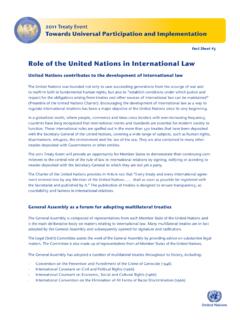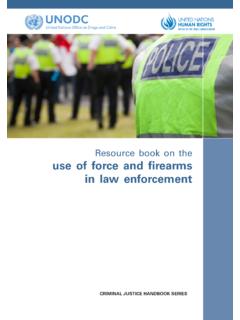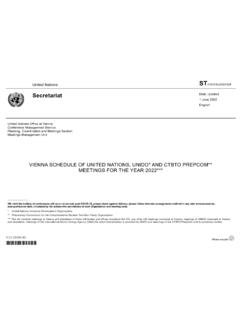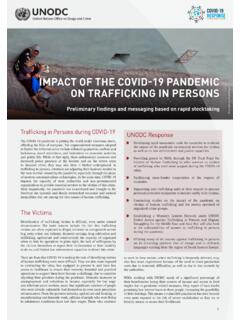Transcription of Recommended Methods for the Identification and Analysis of ...
1 Recommended Methods for the Identification and Analysis of cannabis and cannabis productsVienna International Centre, PO Box 500, 1400 vienna , Austria Tel.: (+43-1) 26060-0, Fax: (+43-1) 26060-5866, nations publicationPrinted in AustriaSales No. *0983942* September 2009 340 Manual for use by national drug Analysis laboratoriesUSD 15 ISBN 978-92-1-148242-3 Photo credits:UNODC Photo Library; UNODC/Ioulia Kondratovitch; Alessandro and Scientific SectionUnited nations office on drUgS and crimeViennaRecommended Methods for the Identification and Analysis of Cannabis and Cannabis Products(Revised and updated)MANUAL FOR USE BY NATIONAL drug Analysis LABORATORIESUNITED NATIONSNew York, 2009 united nations PUBLICATIONS ales No. 978-92-1-148242-3ST/NAR/40 This publication has not been formally language: EnglishNoteOperating and experimental conditions are reproduced from the original reference materials, including unpublished Methods , validated and used in selected national laboratories as per the list of references.
2 A number of alternative conditions and substitution of named commercial products may provide comparable results in many cases, but any modification has to be validated before it is integrated into laboratory routines. Mention of names of firms and commercial products does not imply the endorsement of the united Laboratory and Scientific Section (headed by Justice Tettey) of the united nations office on Drugs and crime (UNODC) wishes to express its thanks to the following experts for their contribution to the contents of the present manual:Dr. Michael Bovens and Mr. Markus Schl pfer, Scientific Forensic Service, Zurich City Police, SwitzerlandMs. Sue Fiddian, Manager, Botany Branch, Forensic Services Department, Victoria Police, Australia; and Illicit Drugs Specialist Advisory Group for Senior Managers of Australian and New Zealand Forensic Laboratories (SMANZFL)Mr.
3 Andrew Holmes, Senior Scientific Advisor, drug Analysis Service, Health Canada, Toronto, CanadaDr. Henk Huizer, Drugs Department, Netherlands Forensic Institute, The Hague, The Netherlands (retired)Mr. A. Kader Jackaria, Forensic Chemist and Toxicologist, MauritiusDr. Lee Tong Kooi, Division Director, Illicit Drugs and Toxicology Division, Applied Sciences Group, Health Sciences Authority, SingaporeMr. Adriano Ot vio Maldaner and Ms. Daniele Zago Souza, Federal Criminal Police, BrazilDr. H. Stambouli, Forensic Science Laboratory, Gendarmerie Royale, Rabat, MoroccoDr. Kalman Szendrei, Professor emeritus, Albert Szent-Gy rgyi University, Szeged, HungaryUNODC s Laboratory and Scientific Section also wishes to express its thanks to Dr.
4 Michael Bovens and Markus Schl pfer for reviewing and updating the original manual Recommended Methods for testing cannabis , for preparing the initial draft of the present revised and updated manual, and for finalizing the manuscript, using additional contributions from the above experts.*Barbara Remberg coordinated this publication for UNODC and wishes to acknowledge the contribution of other UNODC staff. * Dr. Bovens wishes to acknowledge Ms. Lisa Frischknecht for editorial assistance of the initial INTRODUCTION .. 1 Background .. 1 Purpose and use of the manual .. 22. ILLICIT PRODUCTION OF CANNABIS PRODUCTS .. 5 Cannabis market .. 53. DESCRIPTION OF THE CANNABIS PLANT AND ILLICIT CANNABIS PRODUCTS.
5 7 Name .. 7 Synonyms.. 7 Taxonomy .. 7 Physical appearance .. 7 Similarities .. 9 Breeding .. 10 Sinsemilla (Spanish for: no seed ) .. 11 Cloning .. 11 Artificially induced hermaphrodites .. 11 Outdoor production .. 11 Indoor production .. 12 Industrial cannabis.. 12 Flowering .. 12 Harvesting .. 13 Yield .. 13 9-THC distribution in cannabis plants and products .. 14 Biosynthesis .. 14 Cannabis products .. 14 Herbal cannabis .. 15 Cannabis resin (hashish) .. 16 Cannabis resin from Mediterranean countries .. 16 Cannabis resin from South and South-West Asia 17 Cannabis resin from pollinators / ice-o-lators .. 17 Liquid cannabis (hashish oil).
6 18 Cannabis seeds and cannabis seed oil .. 19 Cannabis essential oil .. 19 Estimation of the age of cannabis samples .. 19 drug -type versus fibre-type cannabis .. 20viPage4. CHEMICAL CONSTITUENTS OF FORENSIC SIGNIFICANCE .. 215. QUALITATIVE AND QUANTITATIVE Analysis OF CANNABIS PRODUCTS .. 25 Sampling .. 25 Sampling of plants (indoor and outdoor plantations) .. 25 Sampling of seized cannabis products.. 26 Herbal cannabis .. 26 Cannabis resin .. 26 Liquid cannabis (oil) .. 27 Minimum criteria for positive Identification of cannabis .. 27 Physical examination .. 27 Macroscopic characteristics .. 27 Microscopic characteristics .. 30 Chemical examination.
7 32 General aspects .. 32 Sample preparation for chemical examination .. 33 Preparation of herbal cannabis .. 33 Preparation of cannabis resin .. 33 Preparation of cannabis oil .. 33 Presumptive tests .. 33 Colour tests .. 33 Immunoassays .. 36 Ion mobility spectrometry (IMS) .. 36 Thin-layer chromatography (TLC) .. 36 Gas chromatography-flame ionization detection (GC-FID), without and with derivatization .. 39 Capillary column technique .. 39 Gas chromatography-mass spectrometry (GC-MS) .. 41 High-performance liquid chromatography (HPLC) .. 416. ADDITIONAL ANALYTICAL TECHNIQUES AND APPROACHES FOR THE Analysis OF CANNABIS PRODUCTS.
8 45 GC-FID profiling of seizures of cannabis products .. 45 Solid phase-micro extraction (SPME) .. 45 Stable isotope ratio-mass spectrometry (IRMS) .. 46 DNA profiling .. 467. REFERENCES .. 4711. BackgroundCannabis products are the most widely trafficked drugs worldwide, accounting for 65 per cent of all global seizure cases ( million cases) in 2006. 5,200 metric tons of herb and 1,000 metric tons of resin were seized in 2006. Practically all countries in the world are affected by cannabis trafficking. Similarly, cannabis also remains the most widely used drug worldwide, with an estimated 166 million people having used cannabis in 2006, equivalent to some 4 per cent of the global population aged the same time, especially since the end of the last century, production Methods have become increasingly sophisticated, resulting in the availability in illicit markets of a wide range of cannabis products with widely varying levels of the main psycho-active ingredient, delta-9-tetrahydrocannabinol (THC).
9 Most recently, there has also been a renewed debate about increasing THC content (frequently referred to as potency ) in illicit cannabis of this requires analytical data which are comparable between laboratories and over time. However, most countries do not require by law the detailed Analysis of the THC content of the different products, and where such analyses are carried out, they use a variety of approaches and experimental designs, reducing the comparability of results. For example, the conversion of natural constituents, such as tetrahydro-cannabinolic acid (THCA), by both smoking and under certain analytical conditions into THC, and how this should be reflected in the analytical report, are issues which are not yet standardized worldwide.
10 On the technological side, the Analysis of cannabis products is further complicated by the relatively restricted availability of pure or well defined reference material of THC and other cannabinoids.*The present manual is an updated and significantly revised version of the manual on Recommended Methods for testing cannabis (ST/NAR/8), which was published in 1987. It has been prepared taking into account both developments in analytical technology and advances in the science of cannabis, and with a view to providing the analytical basis for an objective discussion about changes in THC content over time, and differences between regions and products. *In this connection, it is important to be aware that THC was fully characterized only in the mid-1960s, and was only available as pure reference standard from the late 1960s.













